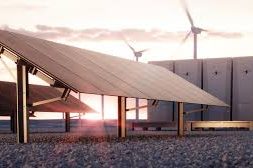
Solar power generation on agricultural land expands in Japan
The sun is being used on more and more farmland across Japan not only to grow crops, but also to generate power. The combination provides a “two-birds-with-one-stone” source of income by allowing the more effective use of farmland.
It also fits in with the government’s goal of net-zero emissions in 2050. But the securing of sunshine, essential for crop growth, for this purpose is not without its issues.
At the Farmdo Group in Gunma Prefecture, solar panels installed on top of greenhouses have been generating electricity since 2014, while mizuna potherb mustard, arugula and lettuce grow inside. Covering a total area of 48 hectares, enough power is produced to supply about 10,000 households.
Under the “feed-in tariff” system, power companies purchase electricity generated from renewable energy sources at a price determined by the government over a period of 20 years. The Farmdo Group expects to recoup its solar-related investment in seven to eight years.
“The additional revenue from selling electricity helps stabilize agricultural operations, and lower the barriers to starting a farm,” a group official said.
To install solar panels, a portion of agricultural land must be converted to non-agricultural use and support poles need to be set up.
According to the Agriculture, Forestry and Fisheries Ministry, the total number of permits for such conversions grew from 96 in fiscal 2013 to 1,992 in fiscal 2018. Over that span, the amount of agricultural land apportioned for solar power generation increased from 19 hectares to 560 hectares.
In Japan, land suitable for solar power generation is limited overall, leading to high expectations for utilizing agricultural land. The Japan Photovoltaic Energy Association estimates that by 2050, about 30% of land used for solar power generation will be agriculture-related.
Chiba Ecological Energy Inc., which provides consulting services on solar power generation on agricultural land, has started trials for using generated electricity to power mowers and sprayers. In the system, electricity stored in a battery can also be used.
As the price of electricity sold to power companies has been falling in recent years, the company will develop a system to provide electricity generation for private use. The aim is also to contribute to local communities by helping them prepare for power outages caused by natural disasters or other events.
There are, however, issues to overcome. Solar panels installed above where crops are growing may block sunlight to other parts of the land, which may hinder the crop growth.
A directive from the agriculture ministry requires farmers who install solar panels to produce 80% or more crops per square meter compared with the regional average. Accordingly, crops needing less sunlight, such as myoga Japanese ginger and fuki Japanese butterbur, are often chosen by farmers.
In regard to the 80% requirement, the ministry has eased the standard for abandoned farmland, after criticism arose at a government meeting that it is “unreasonable for the promotion of renewable energy.” Likewise, there is concern that expansion of solar power generation will lead to a decline in agricultural production capacity.
“It is important to balance agriculture and power generation,” said Takashi Nozu, an associate professor at Waseda University. “It is also necessary to carefully consider how to increase profitability, given the initial investment and maintenance costs involved.”Speech


















